Cohesive Channel Response to Watershed Urbanization: Insights from the Sand River, Aiken SC
Abstract
:1. Introduction
2. Study Site History and Description
3. Materials and Methods
3.1. Watershed Urbanization
3.2. Lidar DEM
3.3. Channel Width, Depth, and Volume
4. Results
4.1. Watershed Urbanization
4.2. Lidar DEM
4.3. Long-Channel Profile
4.4. Channel Width and Depth
4.5. Volume Sediment Flux
5. Discussion
Author Contributions
Funding
Acknowledgments
Conflicts of Interest
References
- Cohen, J. Human population: The next half century. Science 2003, 302, 1172–1175. [Google Scholar] [CrossRef] [PubMed]
- Vorosmarty, C.J.; McIntyre, P.B.; Gessner, M.O.; Dudgeon, D.; Prusevich, A.; Green, P.; Glidden, S.; Bunn, S.E.; Sullivan, C.A.; Reidy Liermann, C.; et al. Global threats to human water security and river biodiversity. Nature 2010, 467, 555–561. [Google Scholar] [CrossRef] [PubMed]
- Lundy, L.; Wade, R. Integrating sciences to sustain urban ecosystem services. Prog. Phys. Geogr. 2011, 35, 653–669. [Google Scholar] [CrossRef]
- Chen, W.Y.; Li, X.; Hua, J. Environmental amenities of urban rivers and residential property values: A global meta-analysis. Sci. Total Environ. 2019, 693. [Google Scholar] [CrossRef] [PubMed]
- Walsh, C.J.; Roy, A.H.; Feminella, J.W.; Cottingham, P.D.; Groffman, P.M.; Morgan, R.P. The urban stream syndrome: Current knowledge and the search for a cure. J. N. Am. Benthol. Soc. 2005, 24, 706–723. [Google Scholar] [CrossRef]
- Zhang, L.; Nan, Z.; Xu, Y.; Li, S. Hydrological impacts of land use change and climate variability in the headwater region of the Heihe River Basin, Northwest China. PLoS ONE 2016, 11. [Google Scholar] [CrossRef]
- Marhaento, H.; Booij, M.J.; Rientjes, T.H.M.; Hoekstra, A.Y. Sensitivity of streamflow characteristics to different spatial land-use configurations in tropical catchment. J. Water Resour. Plan. Manag. 2019, 145. [Google Scholar] [CrossRef]
- Wolman, M.G. A cycle of sedimentation and erosion in urban river channels. Geogr. Ann. 1967, 49A, 385–395. [Google Scholar] [CrossRef]
- Hammer, T.R. Stream channel enlargement due to urbanization. Water Resour. Res. 1972, 17, 1530–1540. [Google Scholar] [CrossRef]
- Booth, D.B. Stream-channel incision following drainage-basin urbanization 1. J. Am. Water Resour. Assoc. 1990, 26, 407–417. [Google Scholar] [CrossRef]
- Bledsoe, B.P.; Watson, C.C. Effects of urbanization on channel instability 1. J. Am. Water Resour. Assoc. 2001, 37, 255–270. [Google Scholar] [CrossRef]
- Leopold, L.B.; Huppman, R.; Miller, A. Geomorphic effects of urbanization in forty-one years of observation. Proc. Am. Philos. Soc. 2005, 149, 349–371. [Google Scholar]
- Frančišković-Bilinski, S.; Bhattacharya, A.K.; Bilinski, H.; Bhattacharya, B.D.; Mitra, A.; Sarkar, S.K. Fluvial geomorphology of the Kupa River drainage basin, Croatia: A perspective of its application in river management and pollution studies. Z. Geomorphol. 2012, 56, 93–119. [Google Scholar] [CrossRef]
- Russell, K.L.; Vietz, G.J.; Fletcher, T.D. How urban stormwater regimes drive geomorphic degradation of receiving streams. Prog. Phys. Geogr. Earth Environ. 2020, 44, 749–778. [Google Scholar] [CrossRef]
- Paul, M.J.; Meyer, J.L. Streams in the urban landscape. Annu. Rev. Ecol. Syst. 2001, 32, 333–365. [Google Scholar] [CrossRef]
- Meyer, J.L.; Paul, M.J.; Taulbee, W.K. Stream ecosystem function in urbanizing landscapes. J. N. Am. Benthol. Soc. 2005, 35, 436–443. [Google Scholar] [CrossRef]
- Violin, C.R.; Cada, P.; Sudduth, E.B.; Hassett, B.A.; Penrose, D.L.; Bernhardt, E.S. Effects of urbanization and urban stream restoration on the physical and biological structure of stream ecosystems. Ecol. Appl. 2011, 21, 1932–1949. [Google Scholar] [CrossRef]
- Horner, R.A.; Garrison, D.L.; Plumley, F.G. Harmful algal blooms and red tide problems on the US west coast. Limnol. Oceanogr. 1997, 40, 1076–1088. [Google Scholar] [CrossRef]
- Hatt, B.E.; Fletcher, T.D.; Walsh, C.J.; Taylor, C.S. The influence of urban density and drainage infrastructure on concentrations and loads of pollutants in small streams. J. Environ. Manag. 2004, 34, 112–124. [Google Scholar] [CrossRef]
- Song, Y.H.; Lee, J.H.; Lee, E.H. Developing a reliability index of low impact development for urban areas. Water 2020, 12, 2961. [Google Scholar] [CrossRef]
- Grimm, N.B.; Sheibley, R.W.; Crenshaw, C.J.; Dahm, C.N.; Roach, W.J.; Zeglin, L.N. N retention and transformation in urban streams. J. N. Am. Benthol. Soc. 2005, 24, 626–642. [Google Scholar] [CrossRef]
- Johnson, L.; Richards, C.; Host, G.; Arthur, J. Landscape influences on water chemistry in Midwestern stream ecosystems. Freshw. Biol. 1997, 37, 193–208. [Google Scholar] [CrossRef]
- Zhou, T.; Wu, J.; Peng, S. Assessing the effects of landscape pattern on river water quality at multiple scales: A case study of the Dongjang River watershed, China. Ecol. Indic. 2012, 23, 166–175. [Google Scholar] [CrossRef]
- Schoonover, J.E.; Willard, K.W.; Zaczek, J.J.; Mangun, J.C.; Carver, A.D. Nutrient attenuation in agricultural surface runoff by riparian buffer zones in southern Illinois, USA. Agrofor. Syst. 2005, 64, 169–180. [Google Scholar] [CrossRef]
- Harmon, S.M.; West, R.T.; Yates, J.R. Identifying fecal pollution sources using 3M Petrifilm count plates and antibiotic resistance analysis in the Horse Creek Watershed in Aiken County, SC (USA). Environ. Monit. Assess. 2014, 186, 8215–8227. [Google Scholar] [CrossRef] [PubMed]
- Booth, D.B.; Roy, A.H.; Smith, B.; Capps, K.A. Global perspectives on the urban stream syndrome. Freshw. Sci. 2016, 35, 412–420. [Google Scholar] [CrossRef] [Green Version]
- Suren, A.M. Effects of urbanization. In New Zealand Stream Invertebrates: Implications for Management; Collier, K.J., Winterbourn, M.J., Eds.; New Zealand Limnological Society: Christchurch, New Zealand, 2000; pp. 260–288. [Google Scholar]
- Cole, J.N.; Miller, A.J.; Stapleton, E.; Welty, C. Quantifying spatial patterns of channel geometry and stream incision in urban drainage network. J. Hydrol. Eng. 2016, 22. [Google Scholar] [CrossRef]
- Whol, E. Rivers in the Anthropocene: The U.S. perspective. Geomorphology 2018, 366, 106600. [Google Scholar] [CrossRef]
- Schumm, S.A.; Harvey, M.D.; Watson, C.C. Incised Channels: Morphology, Dynamics, and Control; Water Resources Publications: Highlands Ranch, CO, USA, 1984. [Google Scholar]
- Trimble, S.W. Stream channel erosion and change resulting from riparian forests. Geology 1997, 25, 467–469. [Google Scholar] [CrossRef]
- Simon, A.; Rinaldi, M. Channel instability in the Loess area of the Midwestern United States. J. Am. Water Resour. Assoc. 2000, 36, 133–150. [Google Scholar] [CrossRef]
- Hawley, R.J.; Bledsoe, B.P. Channel enlargement in semi-arid suburbanizing watersheds: A southern California case study. J. Hydrol. 2013, 496, 17–30. [Google Scholar] [CrossRef]
- Chin, A.; Gidley, R.; Tyner, L.; Gregory, K.J. Adjustment of dryland stream channels over four decades of urbanization. Anthropocene 2017, 20, 24–36. [Google Scholar] [CrossRef]
- Mitra, S.; Roy, A.K.; Tamang, L. Assessing the status of changing channel regimes of Balason and Mahananda River in the Sub-Himalayan West Bengal, India. Earth Syst. Environ. 2020, 4409–4425. [Google Scholar] [CrossRef]
- Bevan, V.; MacVicar, B.; Chapuis, M.; Ghunowa, K.; Papangelakis, E.; Parish, J.; Snodgrass, W. Enlargment and evolution of a semi-alluvial creek in response to urbanization. Earth Surf. Process. Landf. 2018, 43, 2295–2312. [Google Scholar] [CrossRef]
- Dunne, T.; Leopold, L.B. Water in Environmental Planning; Macmillan: New York, NY, USA, 1978. [Google Scholar]
- Leopold, L.B. Hydrology for Urban Land Planning—A Guidebook on the Hydrologic Effects of Urban Land Use. Geological Survey Circular 554; U.S. Geological Survey: Washington, DC, USA, 1968. [Google Scholar]
- Morisawa, M.; LaFlure, E. Hydraulic geometry, stream equilibrium and urbanization. Adjust. Fluv. Syst. 1979, 10, 333–350. [Google Scholar]
- Booth, D.; Reinelt, L.E. Consequences of urbanization on aquatic systems—Measured effects, degradation thresholds, and corrective strategies. In Proceedings of the Watershed ’93: A National Conference on Watershed Management, Alexandria, VA, USA, 21–24 March 1994; pp. 545–550. [Google Scholar]
- Schueler, T. The importance of imperviousness. Watershed Prot. Tech. 1994, 1, 100–111. [Google Scholar]
- Vietz, G.J.; Sammonds, M.J.; Walsh, C.J.; Fletcher, T.D.; Rutherford, I.D.; Stewardson, M.J. Ecologically relevant geomorphic attributes of streams are impared by even low levels of watershed effective imperviousness. Geomorphology 2014, 1, 67–78. [Google Scholar] [CrossRef]
- Utz, R.M.; Hopkins, K.G.; Beesley, L.; Booth, D.B.; Hawley, R.J.; Baker, M.E.; Freeman, M.C.; Jones, K. Ecological resistance in urban streams: The role of natural and legacy attributes. Freshw. Sci. 2016, 35, 380–397. [Google Scholar] [CrossRef] [Green Version]
- Hawley, R.J.; MacMannis, K.R.; Wooten, M.S.; Fet, E.V.; Korth, N.L. Suburban stream erosion rates in northern Kentucky exceed reference channels by an order of magnitude and follow predictable trajectories of channel evolution. Geomorphology 2020, 352, 106998. [Google Scholar] [CrossRef]
- Lane, E.W. Importance of fluvial morphology in hydraulic engineering. Proc. Am. Soc. Civ. Eng. 1955, 81, 1–17. [Google Scholar]
- Hawley, R.J. Making stream restoration more sustainable: A geomorphically, ecologically, and socioeconomically principled approach to bridge the practice with the science. BioScience 2018, 68, 517–528. [Google Scholar] [CrossRef] [PubMed]
- Leopold, L.B.; Wolman, M.G.; Miller, J.B. Fluvial Processes in Geomorphology; W.H. Freeman: San Francisco, CA, USA, 1964. [Google Scholar]
- Arnold, C.L.; Boison, P.J.; Patton, P.C. Sawmill Brook: An example of rapid geomorphic change related to urbanization. J. Geol. 1982, 90, 155–166. [Google Scholar] [CrossRef]
- Roberts, C.E. Flood frequency and urban-induced channel change: Some British examples. In Floods: Hydrological, Sedimentological and Geomorphological Implications; Beven, K., Carling, P., Eds.; Wiley: Chichester, UK, 1989; pp. 57–82. [Google Scholar]
- Booth, D.B.; Henshaw, P.C. Rates of channel erosion in small urban streams. In Geomorphic Processes and Riverine Habitat; American Geophysical Union: Washington, DC, USA, 2001; Volume 2, pp. 17–38. [Google Scholar]
- Julian, J.P.; Torres, R. Hydraulic erosion of cohesive riverbanks. Geomorphology 2006, 76, 193–206. [Google Scholar] [CrossRef]
- Williams, G.P.; Wolman, M.G. Downstream effects of dams on alluvial rivers. In Geological Survey Professional Paper; U.S. G.P.O.: Washington, DC, USA, 1984. [Google Scholar]
- Holley, F.M.; Karim, M.F. Simulations of Missouri River bed degradation. J. Hydraul. Eng. 1986, 112, 497–517. [Google Scholar] [CrossRef]
- Grant, G.E.; Schmidt, J.C.; Lewis, S.L. A geological framework for interpreting downstream effects of dams on rivers. In A Peculiar River, American Geophysical Union, Water Science Application; O’Conner, J.E., Grant, G.E., Eds.; American Geophysical Union: Washington, DC, USA, 2003; Volume 7, pp. 209–225. [Google Scholar]
- Bunte, K. Gravel mitigation and augmentation below hydroelectric dams: A geomorphological perspective. In Report to the Stream Systems Technology Center; USDA Forest Service Rocky Mountain Research Station: Fort Collins, CO, USA, 2004. [Google Scholar]
- Shelley, D.C. Geology, Geomorphology, and Tectonics of the Congaree River Valley, South Carolina. Ph.D. Thesis, University of South Carolina, Columbia, SC, USA, 2007; p. 384. [Google Scholar]
- Bledsoe, B.P.; Stein, E.D.; Hawley, R.J.; Booth, D. Framework and tool for rapid assessment of stream susceptibility to hydromodification. J. Am. Water Resour. Assoc. 2012, 48, 788–808. [Google Scholar] [CrossRef]
- Bledsoe, B.P.; Baker, D.W.; Nelson, P.A.; Rosburg, T.; Sholtes, J.; Stroth, T.R. Design hydrology for stream restoration and channel stability at stream crossings. In Report, National Cooperative Highway Research Program (NCHRP); Department of Civil and Environmental Engineering, Colorado State University: Fort Collins, CO, USA, 2016; pp. 24–40. [Google Scholar]
- Hawley, R.J.; Vietz, G.J. Addressing the urban stream disturbance regime. Freshw. Sci. 2016, 35, 278–292. [Google Scholar] [CrossRef]
- Driscoll, M.O.; Clinton, S.; Jefferson, A.; Manda, A.; McMillan, S. Urbanization effects on watershed hydrology and in-stream processes in the Southern United States. Water 2010, 2, 605–648. [Google Scholar] [CrossRef]
- ASCE Task Committee on Hydraul, Bank Mechanics. River width adjustment. I: Processes and Mechanisms. J. Hydraul. Eng. 1998, 124, 881–902. [Google Scholar] [CrossRef]
- Couper, P.R. Space and time in river bank erosion: A review. Area 2004, 36, 387–403. [Google Scholar] [CrossRef]
- Rinaldi, M.; Mengoni, B.; Luppi, L.; Darby, S.E.; Mosselman, E. Numerical simulation of hydrodynamics and bank erosion in a river bend. Water Resour. Res. 2008, 44. [Google Scholar] [CrossRef] [Green Version]
- Pizzuto, J. An empirical model of event scale cohesive bank profile evolution. Earth Surf. Process. Landf. 2009, 34, 1234–1244. [Google Scholar] [CrossRef]
- Salem, H.; Rennie, C.D. Practical determination of critical shear stress in cohesive soils. J. Hydraul. Eng. 2017, 143, 04017045. [Google Scholar] [CrossRef]
- Edison, G.W.; Sawyer, C.B.; Hichcock, D.R.; Calabria, J.; Putman, B.; Chanse, V.; Post, C.J.; Hallstrom, J.O.; White, D.L.; Esswein, S.T.; et al. Sand River headwaters green infrastructure project, City of Aiken, South Carolina: A collaborative team approach to implementing green infrastructure practices. In Proceedings of the 2010 South Carolina Water Resources Conference, Columbia, SC, USA, 13–14 October 2010. [Google Scholar]
- Osterkamp, W.R.; Hedman, E.R. Variation of width and discharge for natural high-gradient stream channels. Water Resour. Res. 1977, 13, 256–258. [Google Scholar] [CrossRef]
- Council Takes Emergency Action to Correct Drainage Situation. In Aiken Standard Review; Hitchcock Woods Foundation: Aiken, SC, USA, 1955.
- Rabold, D. Turning Back the Sands of Time; Hitchcock Woods Foundation: Aiken, SC, USA, 2008. [Google Scholar]
- Sand River Erosion under Study by City. In Aiken Standard Review; Hitchcock Woods Foundation: Aiken, SC, USA, 1956.
- Southeast Regional Climate Center (SERCC). Period of Record monthly Climate Summary, Raleigh, NC State University, North Carolina. Available online: http://www.sercc.com/cgi-bin/sercc/cliMAIN.pl?nc7079 (accessed on 8 January 2020).
- Nystrom, P.G., Jr.; Willoughby, R.H.; Kite, L.E. Cretaceous and Teritary stratigraphy of the Upper Coastal Plain, SC. In The Geology of the Carolinas; Horton, J.W., Jr., Zullo, V.A., Eds.; University of Tennessee Press: Knoxville, TN, USA, 1991; pp. 221–240. [Google Scholar]
- Newson, M.D.; Large, A.R. ‘Natural’ rivers, ‘hydromorphological quality’ and river restoration: A challenging new agenda for applied fluvial geomorphology. Earth Surf. Process. Landf. 2006, 31, 1606–1624. [Google Scholar] [CrossRef]
- Wayt, H. Railroad tracks belonging to the South Carolina Canal and Railroad Company, c. 1839–1852. J. Soc. Ind. Archaeol. 2016, 42, 19–36. [Google Scholar]
- Gamble, R.; Hogan, T. Watersheds in watersheds: The fate of the planet’s major river systems in the Great Acceleration. Thesis Elev. 2019, 150, 3–25. [Google Scholar] [CrossRef]
- Steffen, W.; Broadgate, W.; Deutsch, L.; Gaffney, O.; Ludwig, C. The trajectory of the Anthropocene: The great acceleration. Anthr. Rev. 2015, 2, 81–98. [Google Scholar] [CrossRef]
- Konrad, C.P.; Booth, D.B. Hydrologic changes in urban streams and their ecological significance. Am. Fish. Soc. Symp. 2005, 47, 157–177. [Google Scholar]
- De Albuquerque, A.O.; De Carvalho, O.A., Jr.; Guimaraes, R.F.; Gomes, A.T.; Hermuche, P.M. Assessment of gully development using geomorphic change detection between pre- and post- urbanization scenarios. Environ. Earth Sci. 2020, 79, 232. [Google Scholar] [CrossRef]
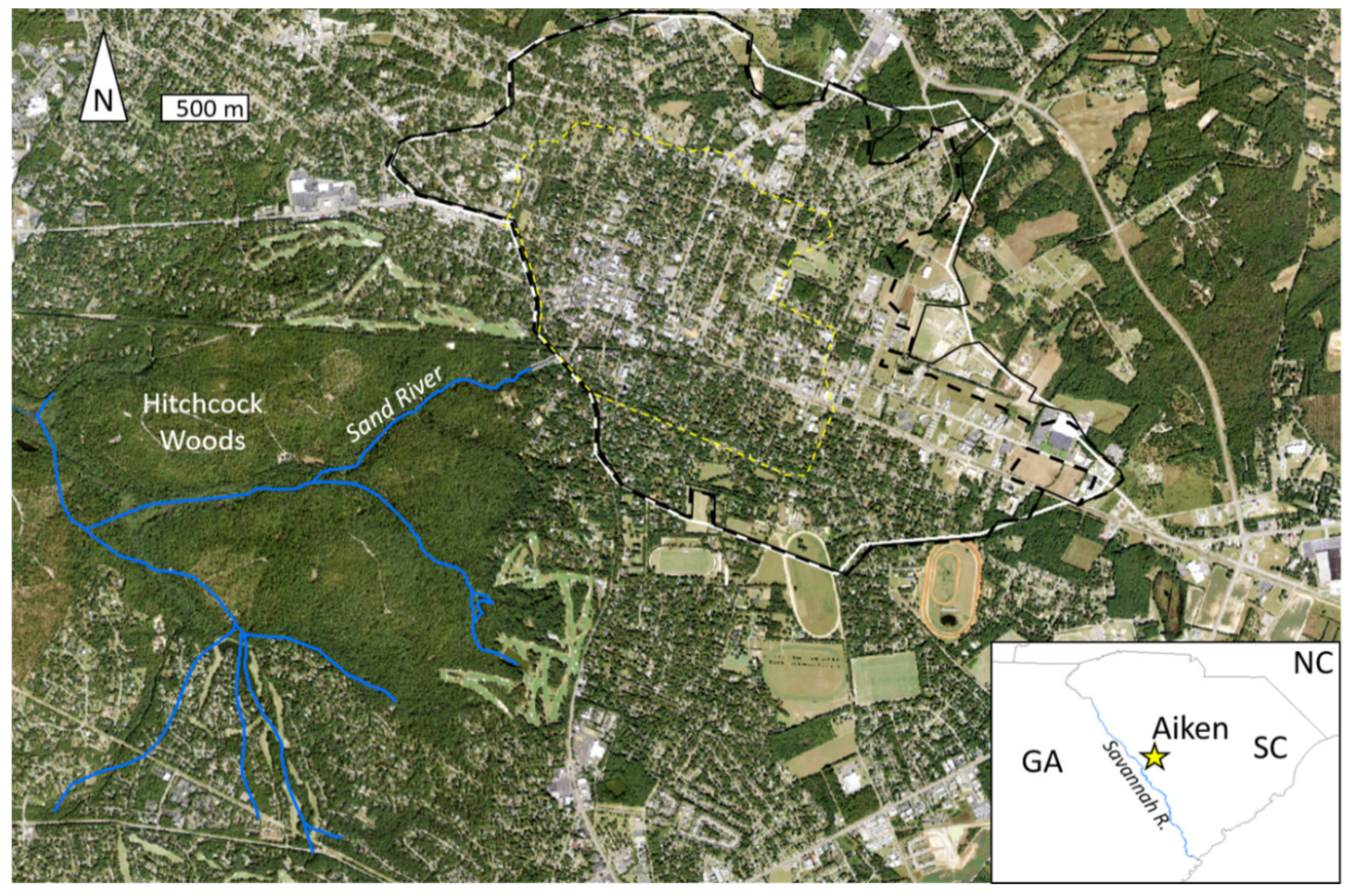
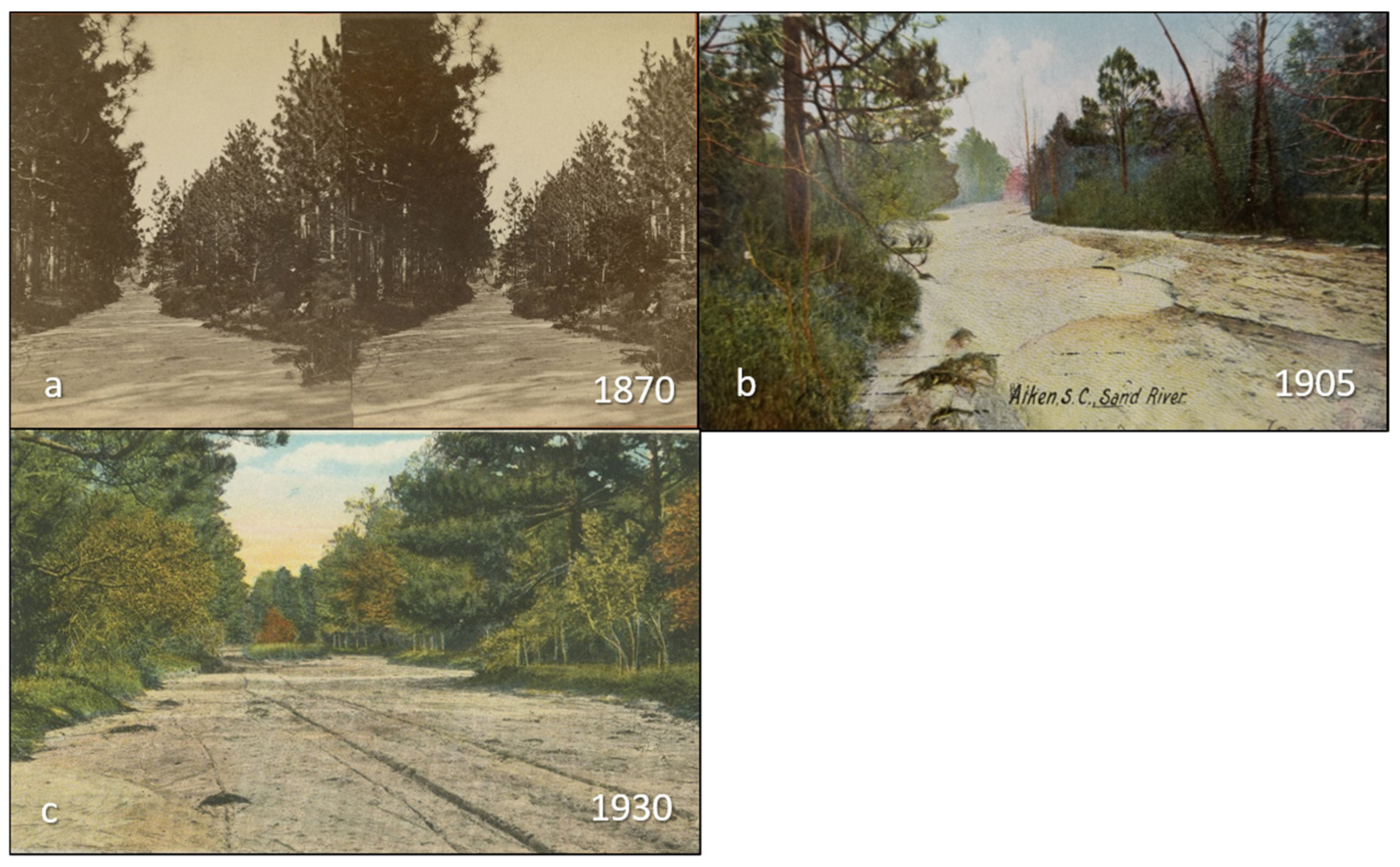
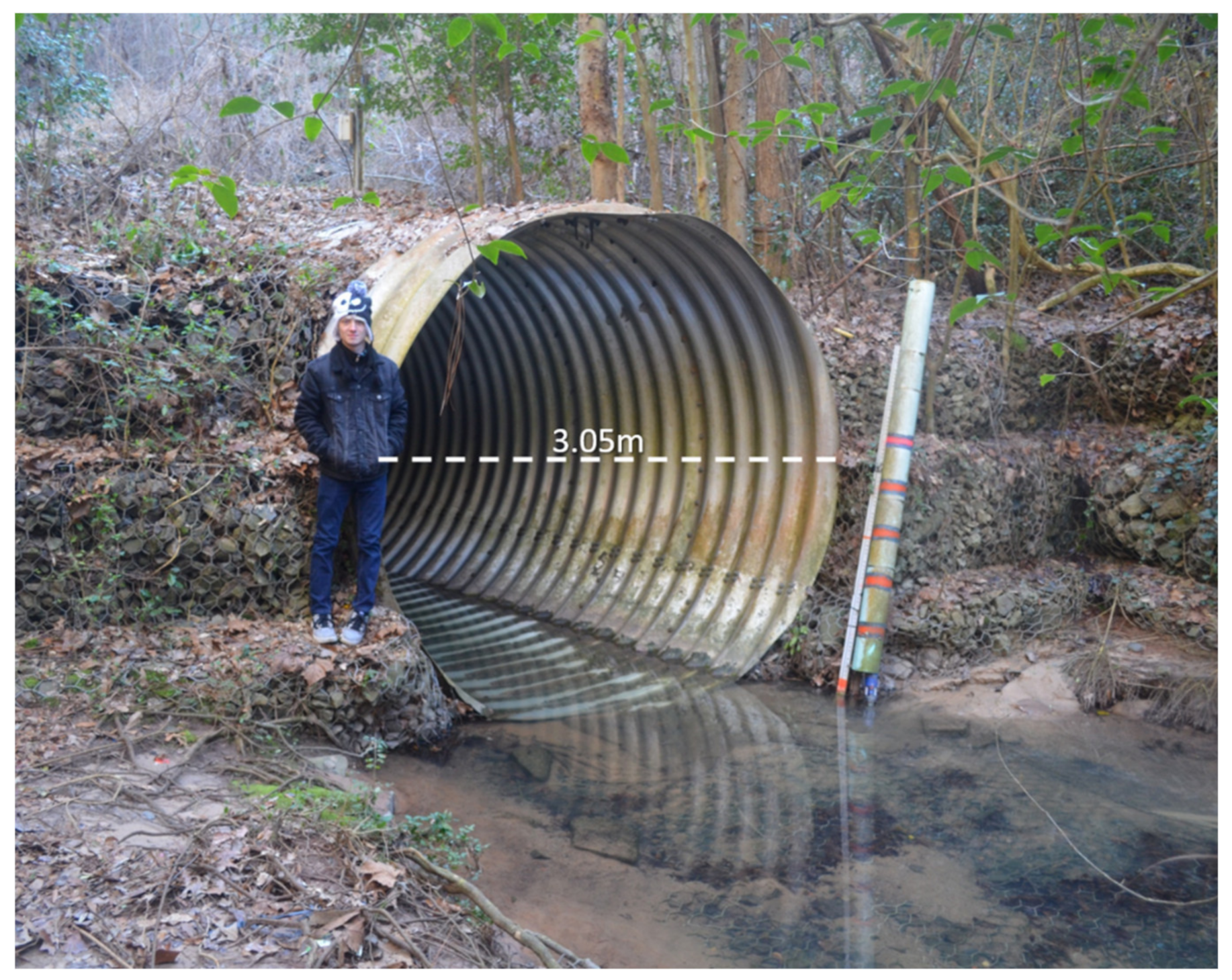

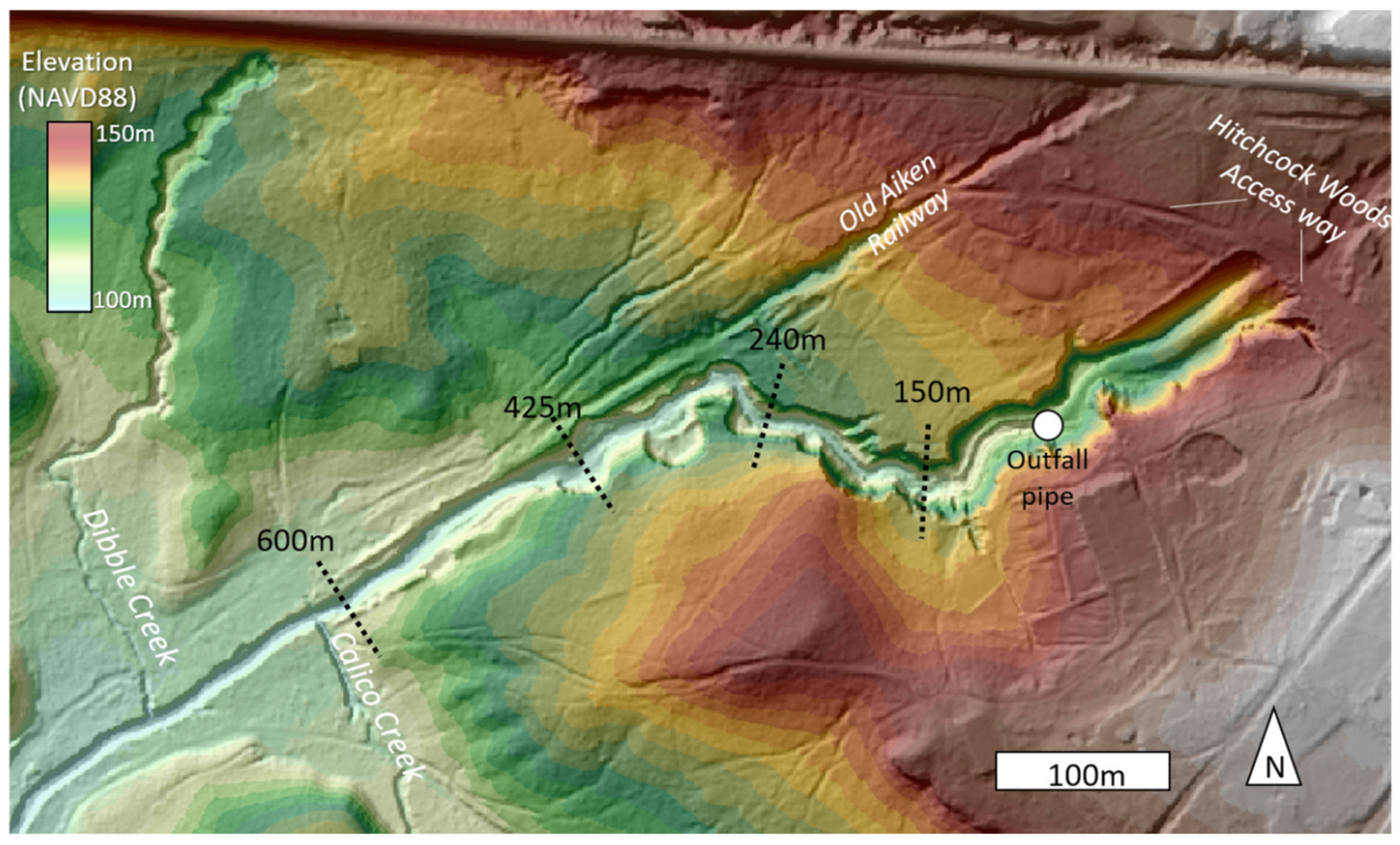
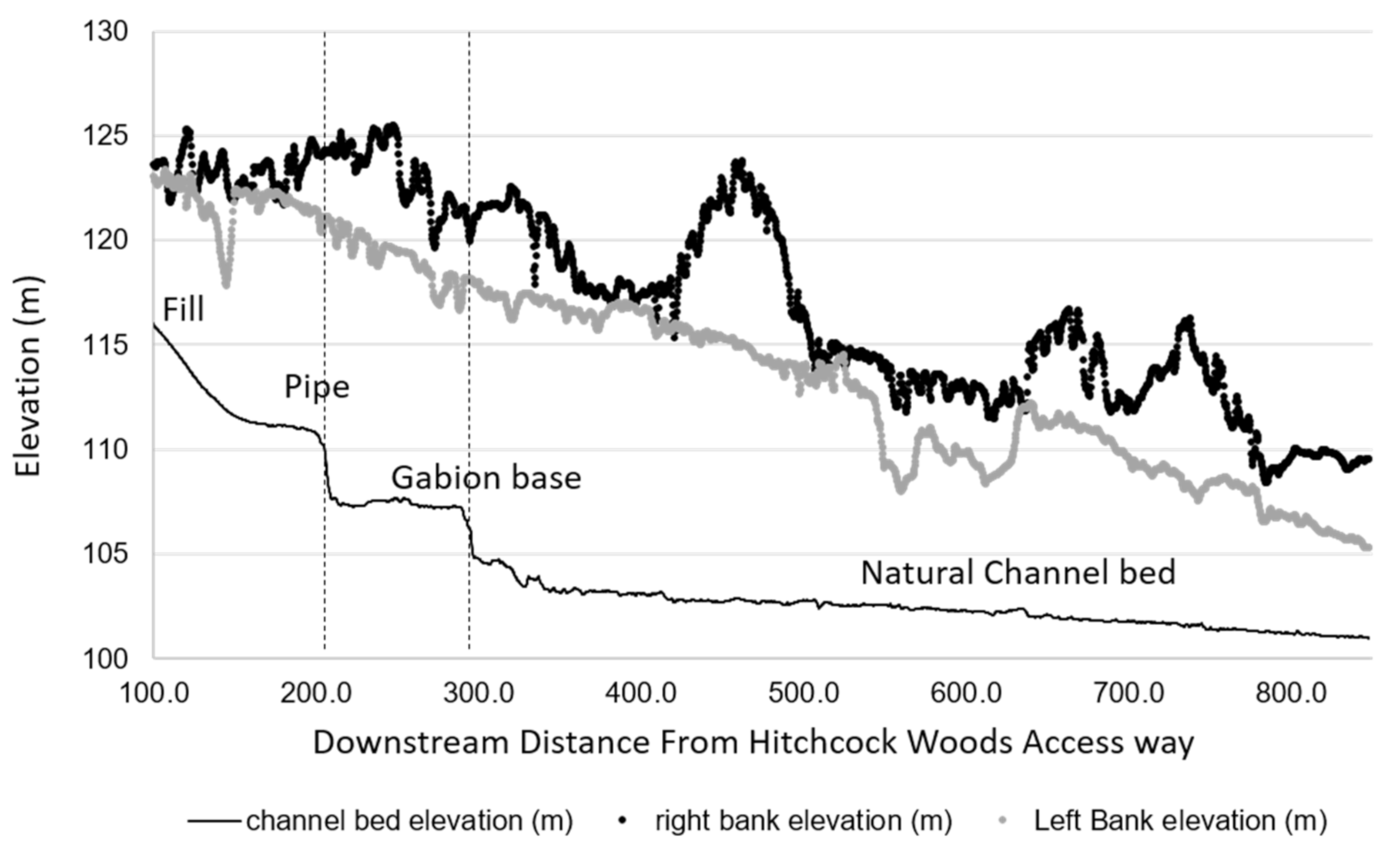
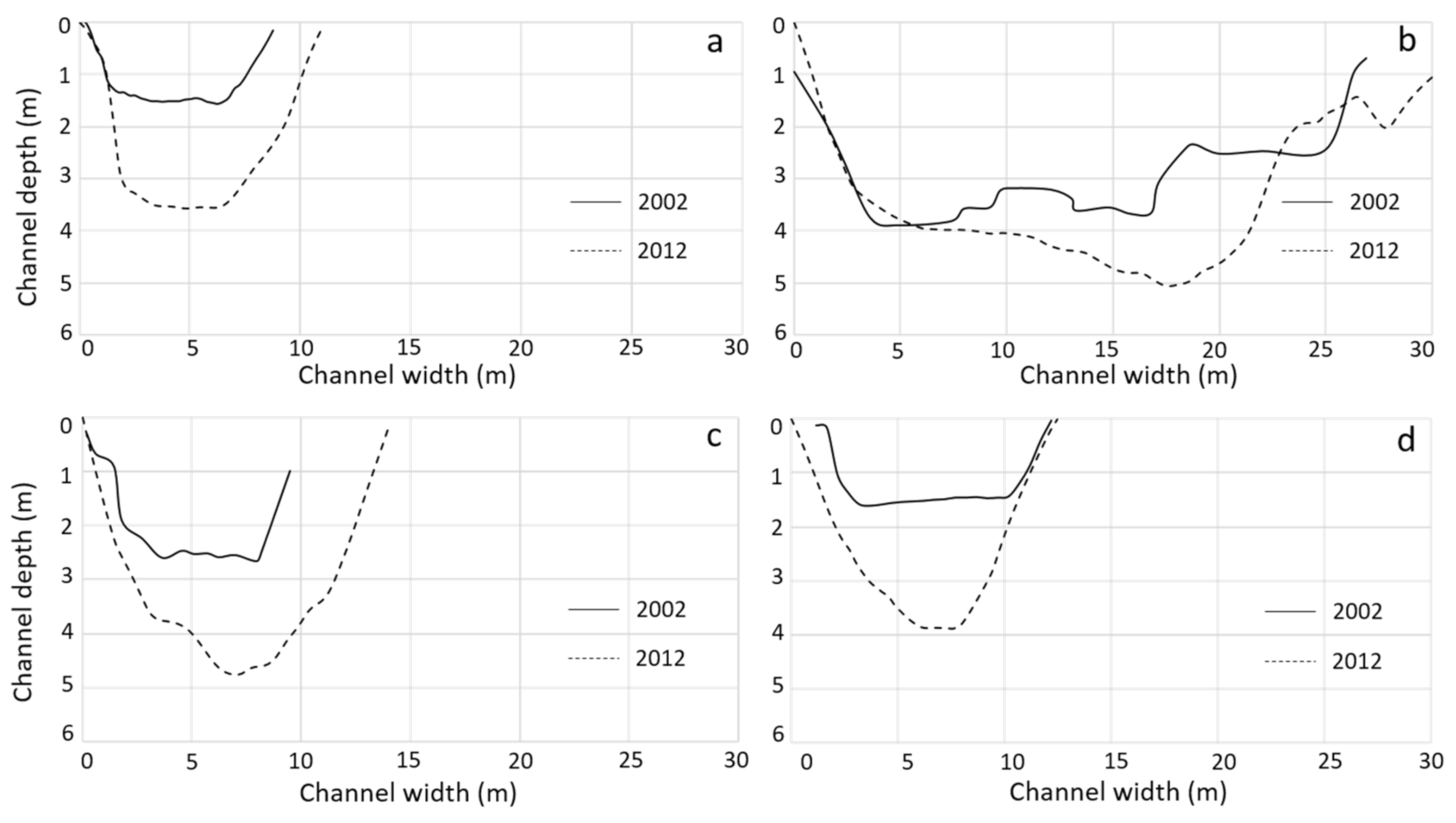
| Year | Watershed Area (km2) | % Increase in Urbanized Watershed Area |
|---|---|---|
| 1930 (initial) | 3.5 | 0 |
| 1992 | 8.11 | 131.7 |
| 2002 | 8.8 | 8.5 |
| 2012 | 9.0 | 2.3 |
| Total % increase (1930–2012) | 157% |
| Time Interval | Channel Volume (m3) | Volume Sediment Flux (m3/yr) |
|---|---|---|
| 1930–1992 | 5.8 × 105 | 9354 |
| 1992–2012 | 4.98 × 104 | 2490 |
| Total canyon volume (2012) | 6.3 × 105 |
Publisher’s Note: MDPI stays neutral with regard to jurisdictional claims in published maps and institutional affiliations. |
© 2020 by the authors. Licensee MDPI, Basel, Switzerland. This article is an open access article distributed under the terms and conditions of the Creative Commons Attribution (CC BY) license (http://creativecommons.org/licenses/by/4.0/).
Share and Cite
Sullivan, J.; Grubb, J.; Willis, R.; Boozer, D.; Flickinger, B.; Dixon, C.E. Cohesive Channel Response to Watershed Urbanization: Insights from the Sand River, Aiken SC. Water 2020, 12, 3441. https://doi.org/10.3390/w12123441
Sullivan J, Grubb J, Willis R, Boozer D, Flickinger B, Dixon CE. Cohesive Channel Response to Watershed Urbanization: Insights from the Sand River, Aiken SC. Water. 2020; 12(12):3441. https://doi.org/10.3390/w12123441
Chicago/Turabian StyleSullivan, Jessica, Joshua Grubb, Ronald Willis, Derek Boozer, Brooks Flickinger, and Christopher Eric Dixon. 2020. "Cohesive Channel Response to Watershed Urbanization: Insights from the Sand River, Aiken SC" Water 12, no. 12: 3441. https://doi.org/10.3390/w12123441




